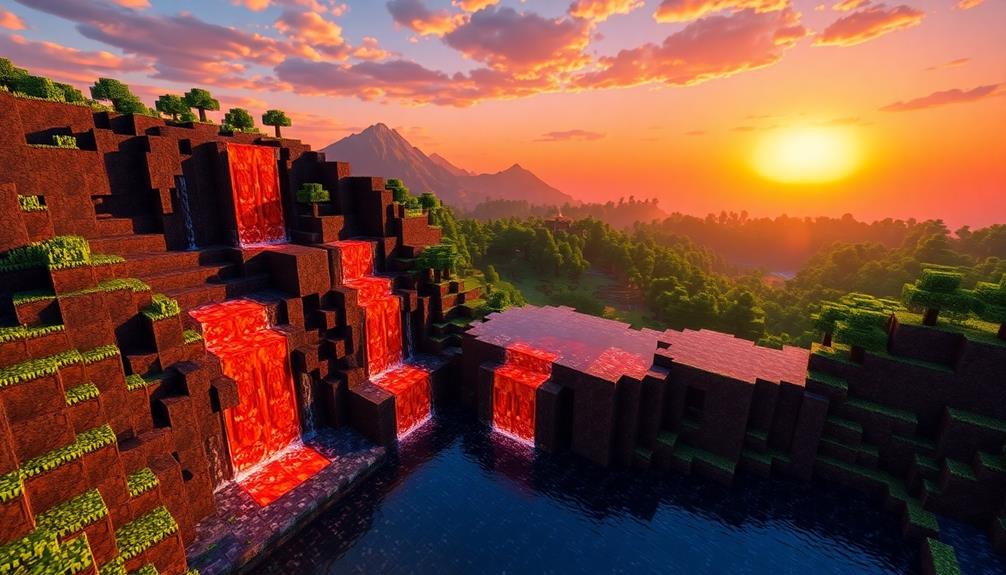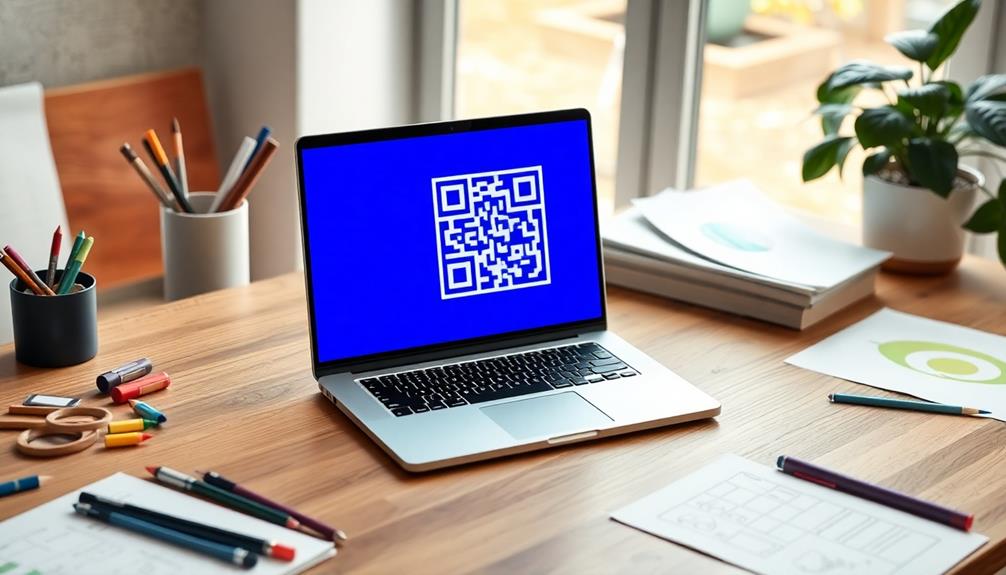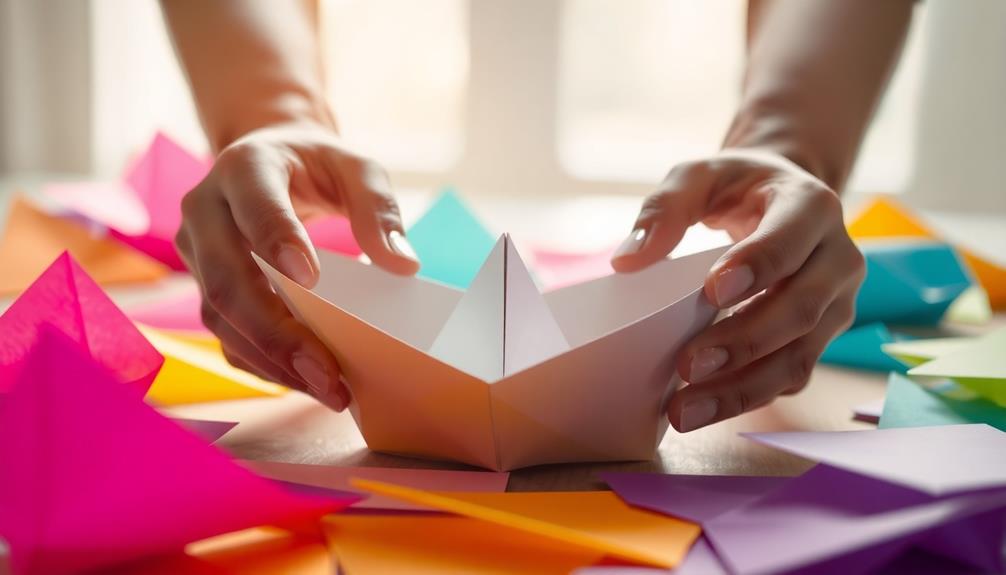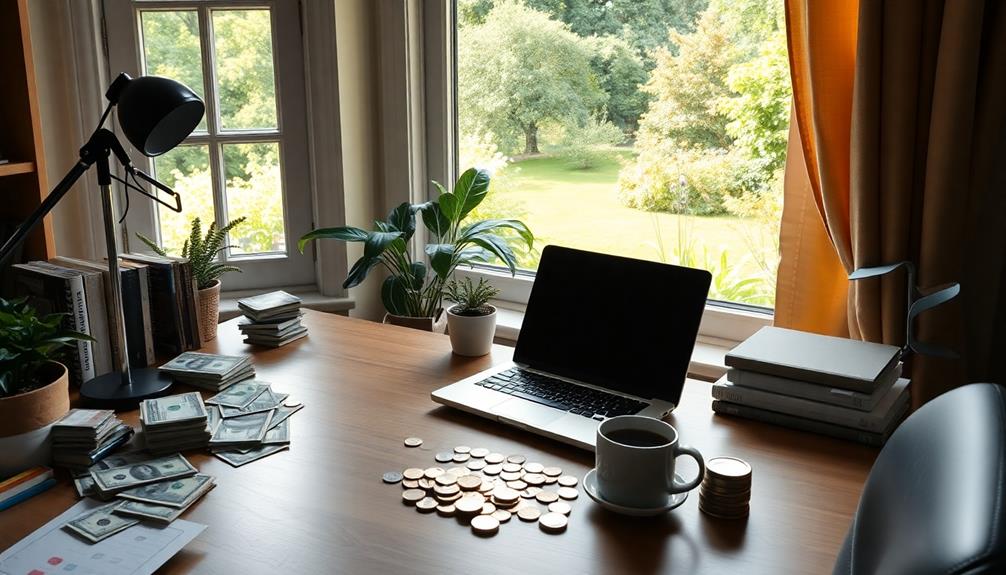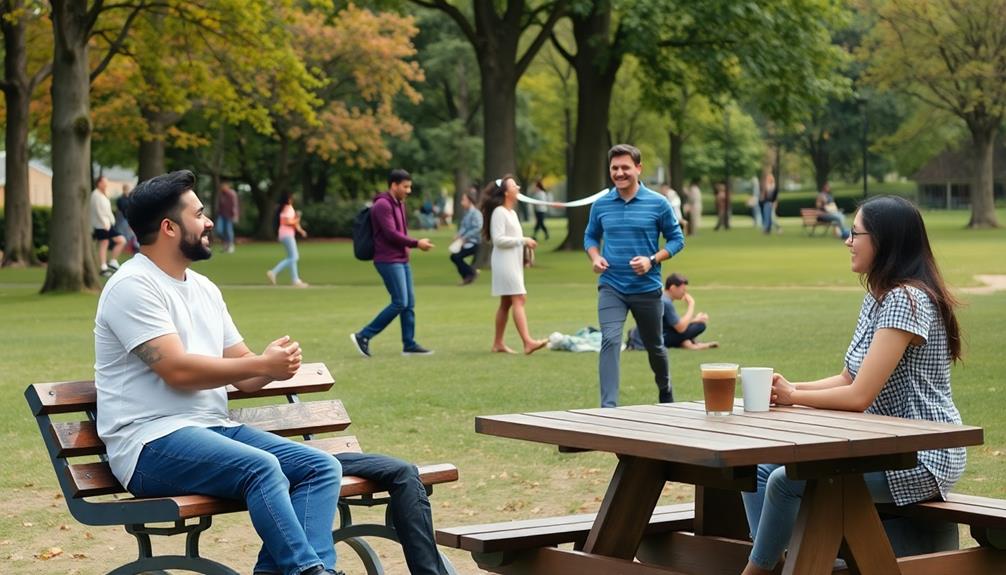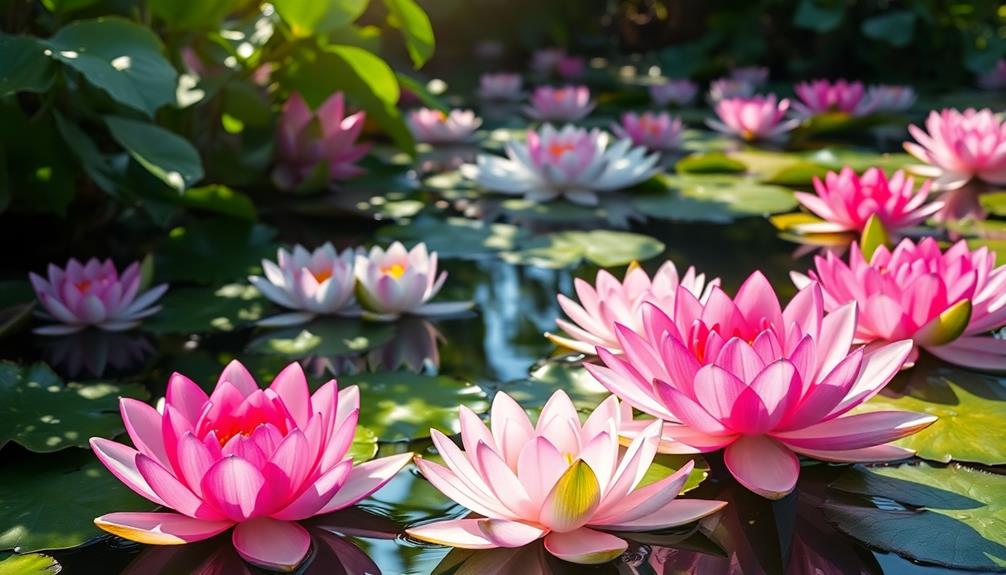To make obsidian in Minecraft, you need to pour water over a stationary lava source. First, locate a lava pool in caves or lower areas. Use a bucket to collect the lava, ensuring it's a source block. Then, simply pour water over the lava, and watch it transform into obsidian. Remember, you'll need a diamond or netherite pickaxe to mine it; using lesser tools will ruin the block. Be careful to monitor underlying lava layers to stay safe while mining. If you're keen to explore more advanced techniques or get tips on farming, just keep going!
Key Takeaways
- Locate a stationary lava pool in caves or lower map layers to start the obsidian creation process.
- Use a bucket to collect lava and pour it over flowing water to transform it into obsidian.
- Ensure you have a diamond or netherite pickaxe, as lesser tools will destroy the obsidian block.
- Maintain a safe distance from lava and build non-flammable structures for a secure workspace.
- Practice efficient obsidian farming techniques to maximize your yield and minimize accidents.
Overview of Obsidian
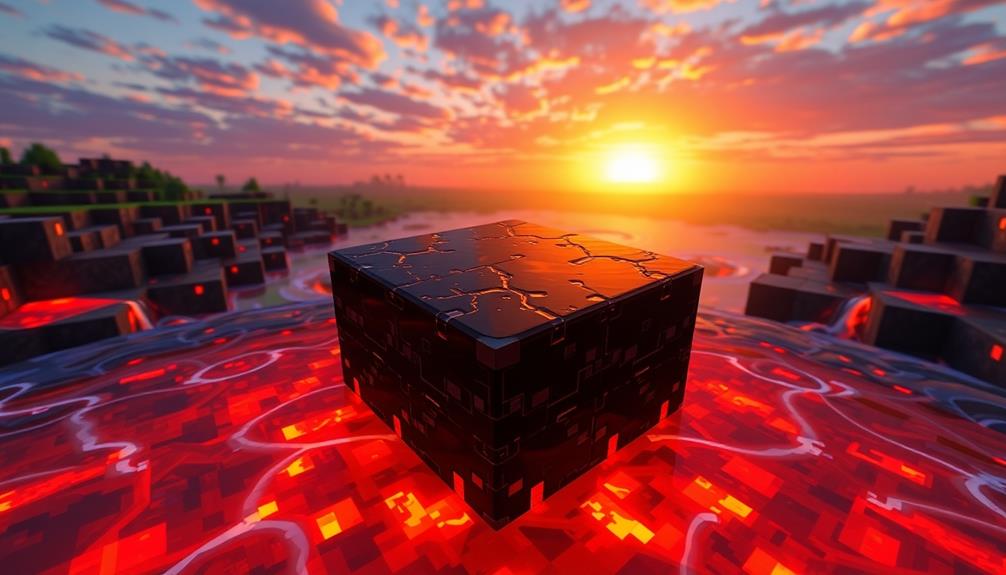
Obsidian is a fascinating block in Minecraft, formed when water cools lava rapidly, resulting in its striking deep purple and black appearance. This volcanic glass block boasts a remarkable blast resistance of 1,200, making it ideal for creating strong structures and defensive bases.
You'll often find obsidian generated where water interacts with stationary lava pools, typically in caves and ravines.
One key thing to note about obsidian is that it can't be crafted, so you must find it in the world. To mine obsidian effectively, you'll need to use a diamond or netherite pickaxe, as using lesser tools will simply destroy the block. The mining time for obsidian is about 9.4 seconds, requiring patience and the right equipment.
Obsidian is also essential for crafting important items in the game. You'll need it to create enchantment tables, beacons, and the frames for Nether portals.
Understanding the properties and uses of obsidian can greatly enhance your gameplay experience, whether you're building defensive structures or planning to explore the Nether. So, keep an eye out for those lava pools to create obsidian!
Methods to Create Obsidian
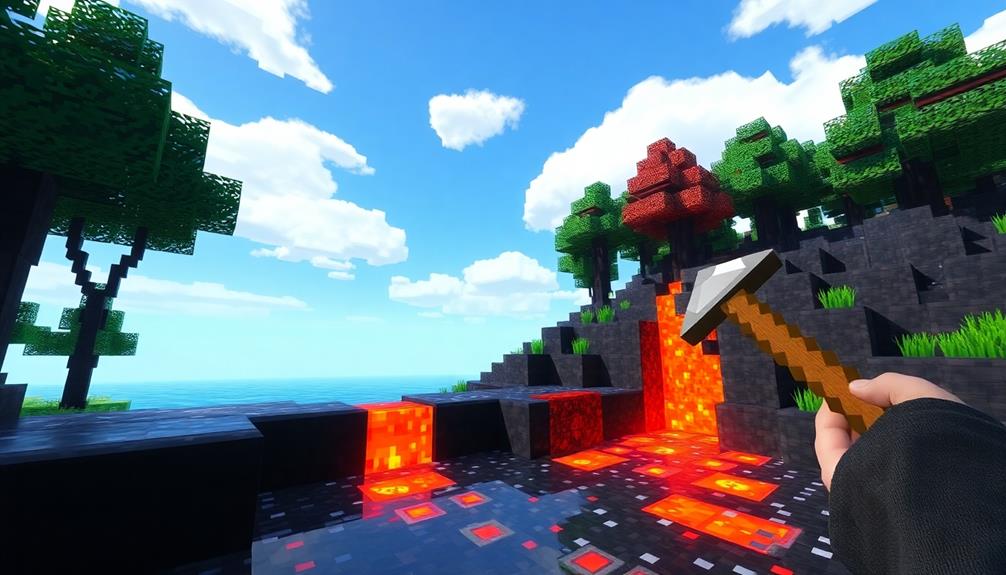
If you're looking to create obsidian, the process is straightforward and requires just a few steps. First, locate a pool of stationary lava, which can be found in caves or at the lower layers of the map. You'll need to pour flowing water over the lava to initiate the transformation into obsidian. Remember, each block of obsidian requires one lava source block, so make sure to collect the lava with a crafted bucket made from three iron ingots.
Here's a quick reference table for you:
| Step | Action |
|---|---|
| 1 | Find a pool of stationary lava |
| 2 | Use a bucket to collect lava |
| 3 | Pour flowing water over the lava |
| 4 | Create blocks of obsidian |
| 5 | Practice obsidian farming for efficiency |
Be cautious of any underlying lava layers when pouring water, as this can lead to burns or lost items. For efficient obsidian farming, utilize renewable lava sources from version 1.17, which allow for easier creation of obsidian. Grab your diamond pickaxes, and you'll be set!
Mining Techniques for Obsidian

Once you've successfully created obsidian, the next step is to mine it efficiently. To do this, you'll need a diamond pickaxe or a netherite pickaxe, as using lesser tools will simply destroy the block of obsidian instead of allowing you to mine it.
Keep in mind that mining obsidian takes about 9.4 seconds without enchantments. However, if you've got an Efficiency V diamond pickaxe, you can reduce this mining time to around 1.6 seconds per block.
To further enhance your obsidian mining, consider utilizing the Haste or Haste II effects from a beacon. These effects can greatly decrease your mining time, making it easier to gather those precious obsidian blocks.
Patience is key during obsidian mining, as the blocks have a hardness of 250, making them among the hardest to break in Minecraft.
Before you start mining, verify you have enough inventory space. Mined blocks will drop themselves, and you don't want to risk losing any to the lava below.
Constructing Nether Portals

Creating a Nether portal is vital for players looking to explore the mysterious and perilous Nether dimension. To construct one, you'll need a minimum of 10 obsidian blocks, arranged in a rectangular frame, allowing optional corners.
It's wise to gather at least 20 obsidian so you can create a second portal for easier navigation between your Overworld portal and the Nether.
Once you've built the frame, you must ignite the interior using flint and steel. This creates the shimmering portal effect that allows you to enter the Nether. Before activation, verify there are no nearby portals that could interfere, as proper spacing is important for the portal to function correctly.
As you prepare to step into the Nether, remember that it's fraught with dangers. Hostile mobs like Ghasts and Piglins await you, alongside various environmental hazards.
Having a second portal can provide a safe return access point, making your exploration more manageable. With your Nether portal constructed and activated, you're ready to face the challenges that lie within the Nether!
Safety Tips for Lava Handling

When you're working near lava in Minecraft, staying vigilant is essential to avoid dangerous accidents. Always maintain a safe distance from lava flows; a slip can lead to character death and the loss of valuable items.
To create a secure workspace while generating obsidian, build temporary non-flammable structures around lava pools. This way, you can focus on your task without worrying about falling into the lava.
Using water buckets strategically can help you flow water over lava without accidentally pushing yourself or your items into the molten hazard. Proper handling of water is vital—always aim to place the water at a safe distance from the edge of the lava.
Additionally, keep an eye on your inventory space. Collecting too much lava or water can lead to dropping essential items near lava hazards, which can be disastrous.
Community Insights on Obsidian

While many players commence on the quest for obsidian, community insights reveal valuable strategies that can enhance your efficiency. One key tip is to guarantee you're using a diamond or netherite pickaxe, as obsidian requires these tools to be mined effectively. Players often highlight the importance of locating natural sources of obsidian, like ruined portals and bastion remnants, which can save you time.
Here are some community-recommended strategies:
| Strategy | Description |
|---|---|
| Temporary Structures | Build non-flammable structures around a pool of lava to prevent accidental falls while creating obsidian. |
| Resource Management | Keep an eye on your inventory space when collecting water and lava for generating obsidian. |
| Automation Techniques | Java players can use the wither to break obsidian, while Bedrock players can barter with piglins for steady supplies. |
Advanced Obsidian Farming Strategies

To ramp up your obsidian farming, you can leverage several advanced techniques that optimize resource usage and efficiency.
Start by utilizing pointed dripstone and cauldrons for renewable lava farming, allowing you to generate consistent lava without depleting natural sources. This method guarantees a steady supply for your obsidian needs.
Next, consider creating automatic obsidian farms using the wither in Java Edition. The wither can efficiently break obsidian blocks, making it ideal for large-scale farming operations.
Additionally, don't overlook bartering systems; linking zombified piglin gold farms can yield obsidian blocks, as there's an 8.71% chance of receiving one for every gold ingot exchanged.
For more controlled farming, set up molds or frames to manage lava flow before dousing it with water to create multiple obsidian blocks in one go.
Finally, enhance your mining speed with beacons providing Haste and Haste II effects. With an Efficiency V diamond pickaxe, you can mine each block in as little as 1.6 seconds.
Frequently Asked Questions
How Do You Turn Lava Into Obsidian in Minecraft?
To turn lava into obsidian, pour water over stationary lava. Guarantee the water flows directly onto the lava, cooling it quickly and transforming it into solid obsidian blocks you can later mine with the right tools.
Why Do I Get Cobblestone Instead of Obsidian?
Isn't it funny? You expect obsidian but end up with cobblestone. That happens when water hits flowing lava. Make certain the lava's still, and you'll finally get the shiny obsidian you've been craving.
How Do You Make Obsidian Instead of Stone in Minecraft?
To create obsidian instead of stone, you'll need to pour water over still lava. Make sure the lava's a source block; flowing lava will only give you cobblestone. Then, mine it with the right tools.
How to Make Unlimited Obsidian?
To make unlimited obsidian, set up a lava farm with pointed dripstone, create a cobblestone generator, or mine regenerating pillars in The End. You can also barter with piglins for additional obsidian blocks.
Conclusion
To sum up, mastering obsidian opens up new possibilities in Minecraft, from crafting powerful tools to building enchanting Nether portals. Imagine the thrill of your first successful portal, standing proud in your base, ready to transport you to a world of adventure. But remember, safety's key—don't let a sneaky lava flow ruin your hard work. Embrace the challenge, experiment with techniques, and soon you'll be creating obsidian like a pro, ready to conquer whatever the game throws at you!

